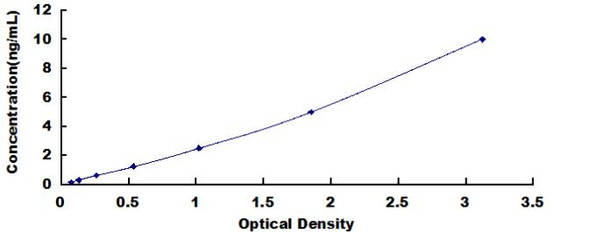Description
| Product Name: | Human VAMP2 Recombinant Protein |
| Product Code: | RPPB5103 |
| Size: | 5µg |
| Species: | Human |
| Target: | VAMP2 |
| Synonyms: | Vesicle Associated Membrane Protein 2, Vesicle-Associated Membrane Protein 2, Synaptobrevin 2, VAMP-2, SYB2, Synaptobrevin-2. |
| Source: | Sf9 Insect cells |
| Physical Appearance: | Sterile Filtered colorless solution. |
| Formulation: | The VAMP2 solution (0.5mg/1ml) contains 0.1mM PMSF, 10% glycerol and Phosphate-Buffered Saline (pH 7.4). |
| Stability: | Store at 4°C if entire vial will be used within 2-4 weeks. Store, frozen at -20°C for longer periods of time. For long term storage it is recommended to add a carrier protein (0.1% HSA or BSA).Avoid multiple freeze-thaw cycles. |
| Purity: | Greater than 95.0% as determined by SDS-PAGE. |
| Amino Acid Sequence: | MGSSHHHHHH SSGLVPRGSH MGSHMSATAA TAPPAAPAGE GGPPAPPPNL TSNRRLQQTQ AQVDEVVDIM RVNVDKVLER DQKLSELDDR ADALQAGASQ FETSAAKLKR KYWWKNLK |
Synaptobrevin-2 or VAMP2 is a protein that has a proline-rich N-terminal part, highly conserved hydrophilic domain, a transmembrane anchor and a C-terminal.VAMP2 found in the transmembrane region of the cell, in the cytoplasmic surface of the synaptic vesicle. The protein is mainly found in the Langerhans islets in the pancreas and glomerular cells in the kidney. A SNARE complex is created within the protein�s N-terminal domain and the target membrane-associated T.
VAMP2 Human Recombinant produced in Sf9 Baculovirus cells is a single, glycosylated polypeptide chain containing 118 amino acids (1-94 a.a) and having a molecular mass of 12.8kDa. VAMP2 is fused to a 24 amino acid His-tag at N-terminus & purified by proprietary chromatographic techniques.
| UniProt Protein Function: | VAMP2: a member of the vesicle-associated membrane protein (VAMP)/synaptobrevin family. Synaptobrevins/VAMPs, syntaxins, and the 25-kD synaptosomal-associated protein SNAP25 are the main components of a protein complex involved in the docking and/or fusion of synaptic vesicles with the presynaptic membrane. Thought to participate in neurotransmitter release at a step between docking and fusion. The protein forms a stable complex with syntaxin, synaptosomal-associated protein, 25 kD, and synaptotagmin. It also forms a distinct complex with synaptophysin. |
| UniProt Protein Details: | Protein type:Motility/polarity/chemotaxis; Vesicle; Membrane protein, integral Chromosomal Location of Human Ortholog: 17p13.1 Cellular Component: zymogen granule membrane; neuron projection; synaptic vesicle membrane; intracellular membrane-bound organelle; clathrin-coated vesicle; integral to plasma membrane; secretory granule membrane; trans-Golgi network; cytosol; secretory granule; SNARE complex; synaptic vesicle; membrane; perinuclear region of cytoplasm; plasma membrane; synapse; cytoplasmic vesicle; cell junction Molecular Function:calmodulin binding; SNAP receptor activity; protein binding; SNARE binding; protein self-association; syntaxin binding; syntaxin-1 binding; phospholipid binding; calcium-dependent protein binding Biological Process: exocytosis; natural killer cell degranulation; neurotransmitter secretion; neutrophil degranulation; pathogenesis; calcium ion-dependent exocytosis; vesicle fusion; regulation of exocytosis; vesicle-mediated transport; synaptic transmission; protein transport; synaptic vesicle exocytosis; cellular protein metabolic process; glutamate secretion; cellular response to insulin stimulus; Golgi to plasma membrane protein transport; response to glucose stimulus; energy reserve metabolic process; eosinophil degranulation; protein complex assembly; post-Golgi vesicle-mediated transport; regulation of insulin secretion |
| NCBI Summary: | The protein encoded by this gene is a member of the vesicle-associated membrane protein (VAMP)/synaptobrevin family. Synaptobrevins/VAMPs, syntaxins, and the 25-kD synaptosomal-associated protein SNAP25 are the main components of a protein complex involved in the docking and/or fusion of synaptic vesicles with the presynaptic membrane. This gene is thought to participate in neurotransmitter release at a step between docking and fusion. The protein forms a stable complex with syntaxin, synaptosomal-associated protein, 25 kD, and synaptotagmin. It also forms a distinct complex with synaptophysin. It is a likely candidate gene for familial infantile myasthenia (FIMG) because of its map location and because it encodes a synaptic vesicle protein of the type that has been implicated in the pathogenesis of FIMG. [provided by RefSeq, Jul 2008] |
| UniProt Code: | P63027 |
| NCBI GenInfo Identifier: | 288558837 |
| NCBI Gene ID: | 6844 |
| NCBI Accession: | P63027.3 |
| UniProt Secondary Accession: | P63027,P19065, Q9BUC2, |
| UniProt Related Accession: | P63027 |
| Molecular Weight: | 13kDa |
| NCBI Full Name: | Vesicle-associated membrane protein 2 |
| NCBI Synonym Full Names: | vesicle-associated membrane protein 2 (synaptobrevin 2) |
| NCBI Official Symbol: | VAMP2�� |
| NCBI Official Synonym Symbols: | SYB2; VAMP-2�� |
| NCBI Protein Information: | vesicle-associated membrane protein 2; synaptobrevin 2; synaptobrevin-2; vesicle associated membrane protein 2 |
| UniProt Protein Name: | Vesicle-associated membrane protein 2 |
| UniProt Synonym Protein Names: | Synaptobrevin-2 |
| Protein Family: | Vesicle-associated membrane protein |
| UniProt Gene Name: | VAMP2�� |
| UniProt Entry Name: | VAMP2_HUMAN |








